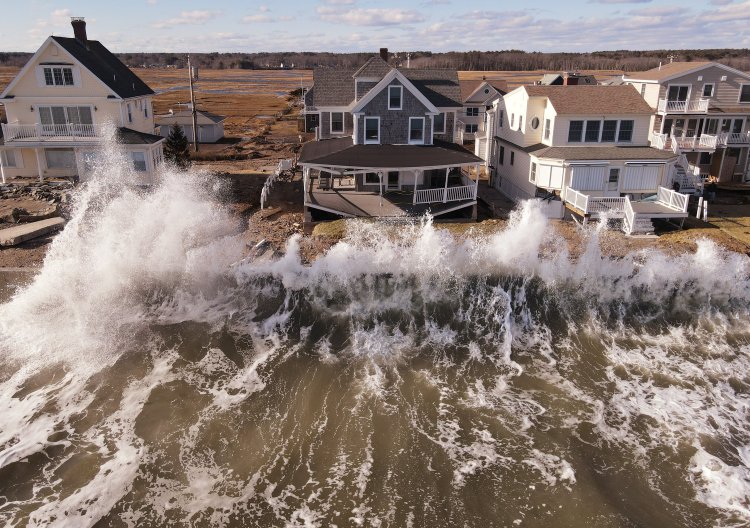Lawmakers consider storm and climate prep bills worth $100M
April 12, 2025

A wave breaks against a seawall in front of homes along Wells Beach during a January 2024 storm that battered the coast and flooded inland communities. Gregory Rec/Portland Press Herald
Maine lawmakers took votes and testimony on two bills this week that would spend more than $100 million to prepare the state for a changing climate and its extreme weather conditions, proving the effects of last winter’s devastating storms are still being felt a year later.
The House and Senate took initial votes on a $34.5 million bill to fund statewide home resiliency grants, improve the emergency communication system and create a new state resilience office. A final round of enactment votes is still needed before that bill can be sent to Gov. Janet Mills, who introduced it earlier this year with bipartisan support.
And on Thursday, the Appropriations and Financial Affairs Committee held a hearing on a proposed $75 million bond to invest in coastal resilience projects, with a special focus on protecting Maine’s sandy beaches from being washed away by sea level rise and storm surge.
“Whether it’s Camp Ellis, the Hook on Chebeague Island or Popham Beach, coastal communities are in crisis,” said Sen. Donna Bailey, D-York, who sponsored the coastal bill. “With this bond, we can ensure that the Maine we all know and love will be here for generations to come.”
The bond bill, LD 560, would ask Maine voters to fund $75 million worth of grants to municipal, county, tribal and regional governments to support climate resilience efforts along Maine’s 3,500 miles of coastline, including the 70 miles of sandy beaches that generate $1.7 billion in annual tourism revenue.
For David Plavin, vice president of Save Our Shores Saco Bay, the bond money is the only way to save some of Maine’s most imperiled beaches. If Maine does nothing, everyone loses, he said. Retreat from the sea becomes a race against time, but eventually the rising tide will catch up.
“There is really no other way to state this other than that without this funding many of the state’s beaches may not survive,” Plavin said. “We cannot put a timetable on this potential apocalypse as storm seasons fluctuate, but after 2024 some sandy shorelines are on the brink of disappearing.”
Some projects that would be likely candidates for bond funding include York County’s effort to upgrade local beaches and dunes to withstand 100-year storms and make them eligible for federally funded sand replacement in the future, said Jeffrey Onnen, vice chair of Saco’s Shoreline Commision.
“Funding for this program is at a critical juncture,” Onnen said. “Compliance enables all southern Maine coastal communities’ access to substantial federal recovery funds at levels never available previously, but establishing this baseline and managing its compliance is both costly and time consuming.”
It is essential for Maine to take responsibility for its own resilience planning and implementation because the Federal Emergency Management Agency is no longer funding some climate mitigation programs, said Arthur Cleaves, director of the York County Emergency Management Agency.
Last winter’s storms destroyed many of the county’s dunes and beaches and left the coastline vulnerable and exposed to the next storm, Cleaves said. In York County alone, municipalities reported $40 million in damages in the federally declared disaster.
Every dollar invested in disaster mitigation saves about $6 in future disaster costs, Cleaves said. The investments that can be made with a $75 million bond issue will create immediate jobs and prevent hundreds of millions in potential damages to the Maine coast for years to come, he said.
Rep. Lori Gramlich, D-Old Orchard Beach, said beach erosion has devastating impacts on Maine’s environment and its coastal economy, especially in communities like hers, where beaches are the cornerstone of the local economy and serve as a protective buffer from the Gulf of Maine.
“The reality of global climate change and the extreme weather events it causes can often seem like a far-off problem, a problem for other states, perhaps California or Florida, to grapple with,” Gramlich said. “January 2024 made it clear that climate change is not a distant threat. Indeed, it’s knocking at our door.”
While Mills’ resiliency bill addresses statewide threats, the bond bill focuses on protecting Maine’s shoreline. But that doesn’t make it any less important to people living in Maine’s interior, Bailey said. Maine’s coastal communities contribute significantly to the entire state economy through tourism, recreation and jobs.
Tourism revenue from our coastal communities and beaches helps fund numerous state programs and services that benefit all Mainers, said Bailey, the senator from York. Also, all Mainers can enjoy Maine’s state beach parks, so making Ferry Beach State Park or Popham Beach State Park more resilient benefits everyone.
ONE OF SEVERAL BONDS
The climate bond is one of several before lawmakers, including: $25 million for sludge treatment, $50 million for Land for Maine’s Future program, $18 million to preserve state historic sites, $45 million to boost the agricultural economy, and $10 million to promote affordable housing in state opportunity zones.
And it would be in addition to Mills’ $34.5 million climate resiliency and storm preparedness bill that appears on the brink of passage. Unlike the climate bond, the climate and storm bill focuses on storm recovery and preparation for the entire state.
That bill, LD 1 creates a $15 million grant program to help Maine residents prepare their homes for storms, increases state funding for disaster relief and preparedness, and creates a $10 million revolving loan fund to help communities qualify for federal disaster relief.
The legislation adopts recommendations in the first report of the Infrastructure Rebuilding and Resilience Commission that Mills created last year following a series of winter storms that killed four people and caused an estimated $90 million in damage to Maine’s public infrastructure.
The proposal would be funded by existing fees collected from insurance companies, most of whom are from out of state, and not from the general fund of the state budget, according to Bob Carey, the state’s insurance superintendent.
With its initial votes complete, the bill will now return to the Senate and House for final votes. Because it is emergency legislation, the bill requires two-thirds majority votes in both chambers before it can head to Mills’ office. If passes by that margin and is signed by Mills, it would go into effect immediately.
Search
RECENT PRESS RELEASES
Related Post


